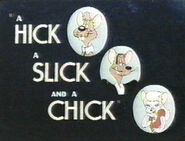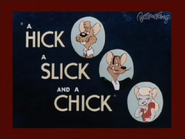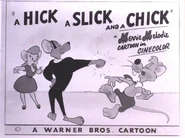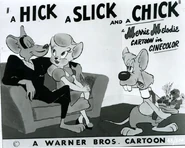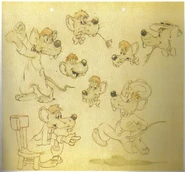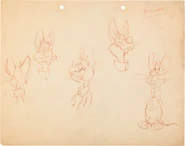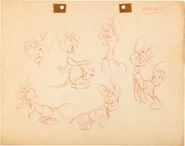A Hick a Slick and a Chick is a 1948 Merrie Melodies short directed by Arthur Davis.
Plot
Elmo (the Hick) gets all slicked up and arrives at his girl's house in the city by hubcap, all while singing "Rural Rhythm". He catches Blackie (the Slick) kissing Daisy Lou (the Chick), and he starts a competition with Blackie for Daisy's affection.
Elmo brings in a handful of flowers; Blackie brings in a florist's shop full of flowers (causing Elmo's flowers to de-age back into seeds). Elmo plays the jaw harp; Blackie plays a piano concerto. Blackie then punches Elmo across the street. Blackie brings Daisy a mink coat, but Elmo says he'll bring back ermine. Elmo accidentally gets drunk in a bottle of champagne, and spots a cat called Herman. Elmo remains unaware of the danger that he is in close proximity with the cat, until a splash of milk from Herman's milk bowl sobers the mouse up.
Both the cat and mouse fight, and Elmo knocks him out. Elmo presents Daisy with an ermine coat, whom the latter then leaves Blackie for Elmo. Blackie wonders where he got ermine, but Herman punches him and says, "Don't get nosy, Junior!" in a Jimmy Durante voice, and turns to show the coat-shaped cutout on his rear end, implying that Elmo has ripped out part Herman's fur to make the ermine coat off-screen. The cartoon irises out in a coat shape as the cat leaves the scene.
Availability
The Golden Age of Looney Tunes Volume 4, Side 6
Notes
- Herman bears a close resemblance to Sylvester the Cat, albeit with red fur in place of Sylvester's black fur, and a black nose in place of Sylvester's red nose. Also, Herman has a different voice.
- Elmo's voice sounds a little like Happy Rabbit.
- The cartoon's concept is somewhat similar to that of "The Hick Chick" (1946) by director Tex Avery at rival studio MGM, as both cartoons feature a love triangle between a hick male, an antagonistic city slicker male, and their female love interest.
- For this short, Warner Bros. along with Turner Entertainment created the two different 1995 music and effects tracks, in order to dub this short in the foreign languages[1].
- When the old a.a.p. print of this cartoon used to be shown on television (including on TBS, TNT and Cartoon Network) before the 1995 Turner "dubbed version" print (regardless of USA or EU prints) takes it's place as of 1995, it's original ending card appears to have been lost, and therefore airs on television with it's ending title card missing.[2][3]. When this cartoon has been released on The Golden Age of Looney Tunes Volume 4 laserdisc in 1993, it's original ending card has been reinstated by editing in the original ending card from "Bone Sweet Bone" (1948, also a Cinecolor one-shot cartoon and directed by Arthur Davis); One can tell that it's taken from another source by the abrupt change in music after the iris-out, as well as the small (but audible) gap of silence in-between both the iris-out and the "That's all, Folks!" ending card, and even having the exact same audio splices in the ending music cue as in Bone Sweet Bone's original ending card.[4][5] [6]
- In the 1995 Turner "dubbed version" print (regardless of both USA or EU prints) seen on current TV airings, though the "That's all, Folks!" ending card is kept intact, however it is still taken from another source; due to it using the 1947-1948 Merrie Melodies dubbed ending card. Despite this, this cartoon's Turner print soundtrack appears to keep it's original ending track intact with no noticeable audio splices in it (evidenced in the video in the infobox here).
- The short notably features in the background of the opening scene of Up in Smoke (1978).
Gallery
References
- ↑ https://www.youtube.com/watch?v=mEpjTxsjqQU&feature=youtu.be
- ↑ https://web.archive.org/web/20011217165933/http://www.megalink.net:80/~cooke/looney/update13.html)
- ↑ https://drive.google.com/file/d/1ZHmTgKJYcnOt4sY2R_ok6ep-8rJDSOrm/view
- ↑ https://archive.org/details/AHickASlickAndAChick
- ↑ https://vk.com/video-20905395_169158325
- ↑ https://vk.com/video-20905395_169158349


